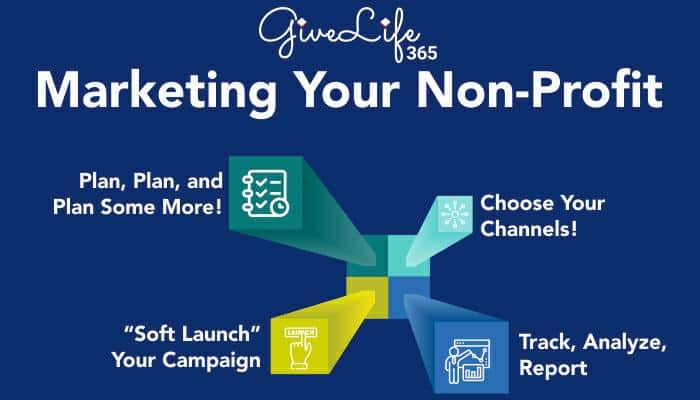

Believe it or not, marketing your Non-Profit is as essential as it is for corporations and employs many of the same techniques to connect with donors, volunteers, and corporate sponsors .
Thankfully, learning how to market your nonprofits — creating awareness, promoting your cause and services, fundraising, and encouraging memberships — doesn’t have to be complicated.
Here are 4 simple steps, you can take, in your organization’s ongoing effort to drive political and social change…

Non-Profit Marketing Ideas
Step 1: Plan, Plan, and Plan Some More!
Whether you're a Non-Profit or business, the same rule applies: To execute a well-designed marketing campaign, you have to plan for success. By this, we mean that your campaign must be tied both strategy and goals.
These goals might include brand awareness, attracting corporate sponsorships, or simply expanding your donor base.
Whatever your goals maybe, you’ll need to plan a strategy for reaching them.
This will undoubtedly include tasks, such as defining your target audience; determining your creative concept; selecting the correct media through which to market your campaign (e.g., print vs. digital); and creating robust estimates of your campaign metrics to measure ongoing success and ROI.
For this, you’ll need a detailed timeline — including a division of responsibilities among board members and volunteers — to hit your strategic targets.
Step 2: “Soft Launch” Your Campaign
When a big company releases a new product, you can bet that they’ve beta tested it.
Beta testing is an opportunity for real users to use a product in a production environment, with the goal of uncovering any bugs so they can be addressed before a general release.
And this is exactly what you’ll want to do with your campaign. It’s also called a “soft launch.”
Creating a marketing plan for soft launch follows the same procedure as any campaign: You’ll want to identify your target audience, establish your goals, your timelines and budget, and of course strategize using a mix of marketing tactics.
But by choosing a small, dedicated group of supporters with whom to beta test your Non-Profit’s campaign, before launch, you’ll be in a better position to identify and solve issues before they become real-world problems.
Step 3: Track, Analyze, Report
How do you know when your campaign is succeeding?
When it comes to marketing, measurable results matter.
The only way to accurately gauge the impact of your marketing efforts is to use a reliable tracking and reporting process. This kind of reporting is even more vital when your company takes a multichannel approach, as we’ll discuss in the next section.
At Alphavima Technologies, we develop custom CRMs that allow nonprofits to track and report on key metrics, as their campaigns unfold.
For example, GiveLife365 is a cloud-based software for Non-Profit organizations that provides tools to help them operate more efficiently and deliver greater social impact. By leveraging Microsoft Dynamics 365 platform, this CRM delivers a modern interface for tracking and reporting, and that is easy to use for managing:
The importance of tracking your campaign’s success, as it unfolds, can’t be underscored enough. By tracking, analyzing, and reporting — both during and after the campaign — you’ll be in a better position to measure results and make incremental improvements.
Step 4: Choose Your Channels!
Marketers can reach consumers in more ways than ever. With so many different options, — ranging from tweets to newspaper ads — it’s easy to get overwhelmed.
But there’s no need to try and do everything.
To make things a bit simpler, a marketing channel refers to any method or platform used for marketing activities. These could include both digital marketing channels (websites, social media, email, apps. etc.) or print marketing (ads, magazines, brochures, etc.).
Choosing the right channels really comes down to asking yourself, “where does my audience live?”
Do they hang out online?
Do they use Facebook and Twitter — or are they primarily email users?
Does your audience read specific news publications, in which your organization might take out an ad?
Whether you’re using more than one channel to reach your audience, as many Non-Profit organizations do, or you rely upon a time-tested email list to get your message out, you have to choose your channels wisely.
Of course, none of this needs to be set in stone. You can always add or subtract channels from your strategy in the future. But, if you’re asking yourself this question for the first time, start by determining the following:
- Which channels you’re currently using.
- Which channels you’ll add to your strategy.
- Which channels you’ll consider putting on pause.
